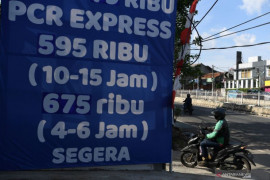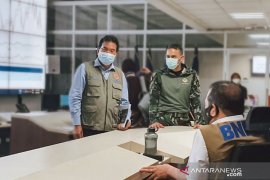This should draw our attention since no change has been made for four weeks and they continue to be red zones. We should understand the problem together with all members of the community and the regions so the condition can become better.Jakarta (ANTARA) -
Ten cities and districts in Indonesia have been classified as red zones, or areas with a high risk of new coronavirus transmission, for the fourth week in a row, the COVID-19 task force noted.
"This should draw our attention since no change has been made for four weeks and they continue to be red zones. We should understand the problem together with all members of the community and the regions so the condition can become better," spokesperson for the COVID-19 task force, Wiku Adisasmito, said at an online press conference at the Presidential Palace here on Thursday.
Three of the 10 areas are in Jakarta province -- West Jakarta, Central Jakarta, and North Jakarta municipalities. The remaining areas are Gorontalo, Hulu Sungai Tengah (South Kalimantan), Ambon (Maluku), Medan (North Sumatra), Deli Serdang (North Sumatra), Balikpapan (East Kalimantan), and Sidoarjo (East Java).
The number of COVID-19 cases and deaths in three municipalities of Jakarta have continued to increase, while their recovery rates have also been on the rise, Adisasmito said.
"The cases are still showing an upward trend. Cumulatively, the cases hit a weekly record high last week, while mortality rates continue to increase. Just in a week, 116 deaths were recorded," he said.
Gorontalo is another city that has remained classified as a red zone for the past four weeks. However, additional COVID-19 cases in the city have declined to 41.3 percent of the peak cases.
The additional COVID-19 cases need to be curbed further to 50 percent, Adisasmito said.
Hulu Sungai Tengah district in South Kalimantan is still being classified as a red zone, but if its curve of COVID-19 cases goes down, it can be deemed an orange zone, or area with a moderate risk of COVID-19 transmission, he said.
In Maluku, Ambon city has remained a red zone. "Ambon city saw the number of positive cases declining to 5.6 percent of the peak cases only last week. The number of COVID-19 cases reached its peak two weeks ago, and the recovery rate can actually be increased. If the recovery rate is increased, the condition will become better," Adisasmito said.
In Medan, which has also been classified as a red zone, the number of new COVID-19 cases and deaths are still in the peak phase, he informed.
"The recovery rate has reached 54 percent (in Medan). The rate can be further increased. Once again, the handling of (COVID-19) cases at hospitals is one of the important keys in addition to early detection or diagnosis so the patients can be well treated," he said.
Related news: 15 mln Indonesians likely to get COVID-19 vaccine by year-end
Related news: Indonesia records 3,166 COVID-19 recoveries, bringing tally to 118,575
Translator: Indra Arief P/Suharto
Editor: Gusti Nur Cahya Aryani
Copyright © ANTARA 2020












